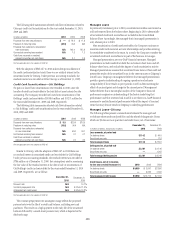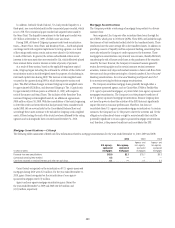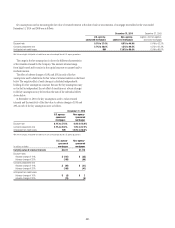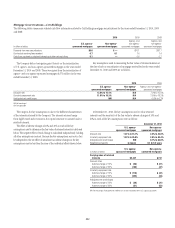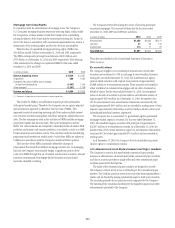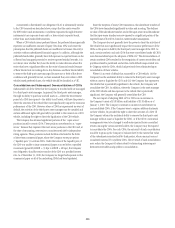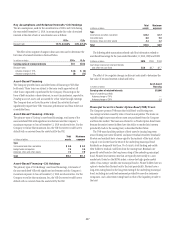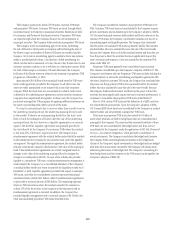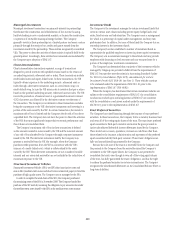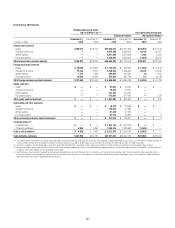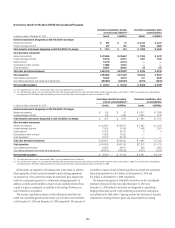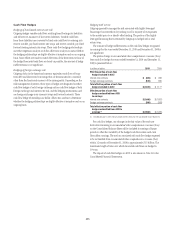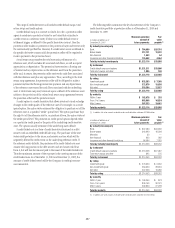Citibank 2010 Annual Report Download - page 250
Download and view the complete annual report
Please find page 250 of the 2010 Citibank annual report below. You can navigate through the pages in the report by either clicking on the pages listed below, or by using the keyword search tool below to find specific information within the annual report.248
The Company sponsors two kinds of TOB trusts: customer TOB trusts
and proprietary TOB trusts. Customer TOB trusts are trusts through which
customers finance investments in municipal securities. Residuals are held
by customers, and floaters by third-party investors. Proprietary TOB trusts
are trusts through which the Company finances its own investments in
municipal securities. The Company holds residuals in proprietary TOB trusts.
The Company serves as remarketing agent to the trusts, facilitating
the sale of floaters to third parties at inception and facilitating the reset of
the floater coupon and tenders of floaters. If floaters are tendered and the
Company (in its role as remarketing agent) is unable to find a new investor
within a specified period of time, it can declare a failed remarketing (in
which case the trust is unwound) or it may choose to buy floaters into its own
inventory and may continue to try to sell them to a third-party investor. While
the level of the Company’s inventory of floaters fluctuates, the Company
held none of the floater inventory related to the customer or proprietary TOB
programs as of December 31, 2010.
Approximately $0.6 billion of the municipal bonds owned by TOB trusts
have a credit guarantee provided by the Company. In all other cases, the
assets are either unenhanced or are insured with a monoline insurance
company. While the trusts have not encountered any adverse credit events
as defined in the underlying trust agreements, certain monoline insurance
companies have experienced downgrades. In these cases, the Company has
proactively managed the TOB programs by applying additional insurance on
the assets or proceeding with orderly unwinds of the trusts.
If a trust is unwound early due to an event other than a credit event on
the underlying municipal bond, the underlying municipal bond is sold
in the market. If there is an accompanying shortfall in the trust’s cash
flows to fund the redemption of floaters after the sale of the underlying
municipal bond, the trust draws on a liquidity agreement in an amount
equal to the shortfall. Liquidity agreements are generally provided to
the trust directly by the Company. For customer TOBs where the residual
is less than 25% of the trust’s capital structure, the Company has a
reimbursement agreement with the residual holder under which the residual
holder reimburses the Company for any payment made under the liquidity
arrangement. Through this reimbursement agreement, the residual holder
remains economically exposed to fluctuations in the value of the municipal
bond. These reimbursement agreements are actively margined based on
changes in the value of the underlying municipal bond to mitigate the
Company’s counterparty credit risk. In cases where a third party provides
liquidity to a proprietary TOB trust, a similar reimbursement arrangement is
made whereby the Company (or a consolidated subsidiary of the Company)
as residual holder absorbs any losses incurred by the liquidity provider. As of
December 31, 2010, liquidity agreements provided with respect to customer
TOB trusts, and other non-consolidated, customer-sponsored municipal
investment funds, totaled $10.1 billion, offset by reimbursement agreements
in place with a notional amount of $8.6 billion. The remaining exposure
relates to TOB transactions where the residual owned by the customer is
at least 25% of the bond value at the inception of the transaction and no
reimbursement agreement is executed. In addition, the Company has
provided liquidity arrangements with a notional amount of $0.1 billion for
other unconsolidated proprietary TOB trusts described below.
The Company considers the customer and proprietary TOB trusts to be
VIEs. Customer TOB trusts were not consolidated by the Company in prior
periods and remain unconsolidated upon the Company’s adoption of SFAS
167. Because third-party investors hold residual and floater interests in the
customer TOB trusts, the Company’s involvement includes only its role as
remarketing agent and liquidity provider. The Company has concluded
that the power over customer TOB trusts is primarily held by the customer
residual holder, who may unilaterally cause the sale of the trust’s bonds.
Because the Company does not hold the residual interest and thus does not
have the power to direct the activities that most significantly impact the
trust’s economic performance, it does not consolidate the customer TOB
trusts under SFAS 167.
Proprietary TOB trusts generally were consolidated in prior periods.
They remain consolidated upon the Company’s adoption of SFAS 167. The
Company’s involvement with the Proprietary TOB trusts includes holding the
residual interests as well as the remarketing and liquidity agreements with
the trusts. Similar to customer TOB trusts, the Company has concluded that
the power over the proprietary TOB trusts is primarily held by the residual
holder, who may unilaterally cause the sale of the trust’s bonds. Because
the Company holds residual interest and thus has the power to direct the
activities that most significantly impact the trust’s economic performance, it
continues to consolidate the proprietary TOB trusts under SFAS 167.
Prior to 2010, certain TOB trusts met the definition of a QSPE and were
not consolidated in prior periods. Upon the Company’s adoption of SFAS
167, former QSPE trusts have been consolidated by the Company as residual
interest holders and are presented as proprietary TOB trusts.
Total assets in proprietary TOB trusts also include $0.5 billion of
assets where residuals are held by hedge funds that are consolidated and
managed by the Company. The assets and the associated liabilities of these
TOB trusts are not consolidated by the hedge funds (and, thus, are not
consolidated by the Company) under the application of ASC 946, Financial
Services—Investment Companies, which precludes consolidation of
owned investments. The Company consolidates the hedge funds, because
the Company holds controlling financial interests in the hedge funds.
Certain of the Company’s equity investments in the hedge funds are hedged
with derivatives transactions executed by the Company with third parties
referencing the returns of the hedge fund. The Company’s accounting for
these hedge funds and their interests in the TOB trusts is unchanged by the
Company’s adoption of SFAS 167.


